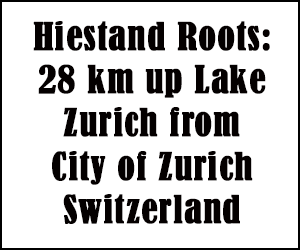|
|
|
|
|
|
Swiss-Germans, Settlers in Southeastern Pennsylvania, Originally from Switzerland ...while it is ordinarily said that the forefathers of this [southeastern] section of Pennsylvania are of German descent, that such tradition is not strictly accurate. They are originally Swiss. Many of our ancestors, however, were pushed by prosecution from Switzerland into Germany and particularly into the Palatinate on the Rhine and lived there some years, migrating from that place to Eastern Pennsylvania. Page 88 of Swiss and German Pioneer Settlers of Southeastern Pennsylvania by H. Frank Eshleman. Originally published in 1917 and reprinted in 2000 in Baltimore, MD by the Genealogical Publishing Company, Inc. |
|
|
Hiestands, Swiss Anabaptists Originally from Canton* Zurich in Switzerland The Swiss element among the Pennsylvania Germans is the largest of the ethnic components of the population. It is particularly strong in Lancaster, Lebanon, and other counties where there are Mennonite and Amish settlements. These descendants of the Swiss Anabaptists have given their character from Canton Bern are Stauffer, Schenk, Longenecker, Forney [Fahrni], Eby, [Aebi]; from Canton* Zurich, Landis, Nissley [Nussli], Denlinger [Dandliker], Hiestand, and others. *Canton = state Page 9 of Pennsylvania German Roots Across the Ocean, edited by Marion F. Egge. Published by the Genealogical Society of Pennsylvania, 2000). |
 |
From the 1835 Journal of Henry
Hiestand, Great-Nephew of Daniel Haston Having learnt, since I came to this place [Zurich, Switzerland], that a person of my name resides some ten or twelve miles [actually 28 km) up the lake [Lake Zurich], I set off in a hack in search of him. I found him. His name is Henry Hiestand, and is undoubtedly a branch of our family, but we could not trace our lineage or genealogy, and indeed that would be difficult in the absence of documentary evidence, as my ancestors have been from this country [Switzerland] one hundred and thirty years. Note: If interpreted precisely, this would indicate that the Hiestand family left Switzerland (for Germany) in 1705. Page 147 of Travels in Germany, Prussia and
Switzerland by Henry Hiestand (born 1788 in Shenandoah County, VA).
While in Switzerland some years ago I jotted down some of the Lancaster county names I found in the graveyards.... In Horgen [in Canton Zurich, near Wädenswil] graveyard were Hiestand and .... Page 38 of "Lancaster County, Pennsylvania, Families from the Canton of Zurich Switzerland" by Oscar Kuhns in the National Genealogical Society Quarterly, Volume VIII, Number 3, October 1919. Link Pages 291-292 of "From the Canton of Zurich, Switzerland" by Oscar Kuhns in The Pennsylvanian German, Volume 11: Editors Croll, Schuler, and Kriebel. |
|
|
|
|
|
|
|
|
|
| Historical Sketch of Richterswil
The village was probably founded in about 850 A.D., but is first mentioned by name (Richtliswile) in 1265 A.D. The people of Richterswil established quite a reputation for revolting against civic and religious authorities they deemed to be unjust, including the Anabaptist movement protesting the dominance of the Catholic Church and the Swiss Reformed Church in the 16th and 17th centuries and the Wädenswil tax revolt of 1645/46. One mile northwest of Richterswil, along the shore, is Wädenswil. Wädenswil is known for the Catholic Order of St. John and the "old" Wädenswil Castle, the ruins of which are within the municipality of Richterswil. With a 2015 population of more than 13,000 and 4,452 households, Richterswil is no longer a village. According to the 2008 census, 45% were Protestant (41.8% belonging to the Swiss Reformed Church), 34.5% were Catholic, 12.2% were atheists or agnostics, with the others begin Muslim, another religion, or an unnamed religion.
Anabaptist Families from Canton Zurich to
Lancaster County, 1633 to 1729: A Tour Download the Article
|
||
|
"Notations of the earliest surnames around the castle
were sporadic in the 1300s. Many of the common folk only kept
first names and occasionally
a secondary name that served as a locator. In the earliest
regional tax lists from the Order of St. John, dating from 1402*,
Hiestand [and other names] appeared for the first time."
From that time on, up until the present day, the Hiestand name has appeared in Richterswil, although many Hiestands have emigrated from Switzerland and now appear around the world by the Hiestand name, or many variations that have morphed out of it. |
||
Although the name generally appears ending with a "d," German-written signatures of Henry Hiestand's sons, such as those of Peter, in his family Bible record, clearly ended with the consonant "t"--Hiestandt. And Daniel's 1777 German signature also appears to end with a "t." Even when English clerks put their English-minded spellings to the Swiss-German surname, often it is apparent that they heard the "t" ending when Henry's family members pronounced their names, as did the person who recorded the name of "Daniel Hasstont" for the petition to create White County, Tennessee in 1806.
Conference of the Hiestand Family in Richterswil (Unknown date)
|
|
|